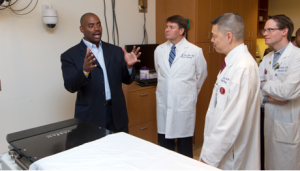 Lung cancer is often perceived as a smoker’s disease. But a hard look at lung cancer diagnosis data reveals that 45 percent of patients with the disease are former smokers, and an additional 15 percent never smoked at all.
Lung cancer is often perceived as a smoker’s disease. But a hard look at lung cancer diagnosis data reveals that 45 percent of patients with the disease are former smokers, and an additional 15 percent never smoked at all.
For Chris Draft, a former San Francisco 49ers linebacker who also played for the Stanford football team, this last statistic is all too real.
His wife, Keasha Draft, never smoked. She was 37 in December 2010 when she was diagnosed with Stage IV lung cancer. She died a year later, a month after she married Chris. According to the Chris Draft Family Foundation’s website, at the time of diagnosis, “her only ‘symptom’ was a slight shortness of breath a few days earlier.”
Typical symptoms of lung cancer are notoriously subtle and often do not appear until the late stages of the disease. They can range from a chronic cough to a slight shortness of breath or an ache in the back, chest or arm. As a result, only 16 percent of lung cancer patients are diagnosed when the cancer is still localized and easily treatable. There is also no current approved screening for early detection of lung cancer. This combination results in a devastatingly low the five-year survival rate.
According a National Cancer Institute study conducted from 1973 to 2008, the five-year survival rate for lung cancer is 16.3 percent—significantly lower than colon cancer (65.2 percent), breast cancer (90 percent), and prostate cancer (99 percent).
However, lung cancer research is also underfunded compared to these other cancers. According to a 2012 American Cancer Society study, lung cancer causes more deaths than the next three most fatal cancers—colon, cancer, and prostate—combined. However, it receives significantly less federal funding than the other three. Breast cancer alone received five times more federal funding than lung cancer in 2011, according to the Lung Cancer Foundation of America.
According to Draft, lung cancer research is underfunded because of the overemphasis on the link between the disease and smoking.
“All you see is a prevention message,” Draft said. “People think that guys who don’t smoke don’t get lung cancer.”
Draft and his wife launched Team Draft at their wedding in November 2011, hoping to use Keasha’s story to change the face of lung cancer, and to prevent it from being labeled a “smoker’s disease.”
Since Team Draft’s inception, Draft has visited over 80 medical centers nationwide.
“I wanted to find out what was being done, out there, in the field,” Draft said. “And who better to go to than the doctors?”
Draft is not only concerned with educating the public about the devastating effects of lung cancer, but also of the efforts being made to fight the disease. He says he hopes to motivate the public donate money and advocate for more lung cancer research.
“The key is hope,” Draft said emphatically. “With every cancer center that we’ve visited, there’s change. Changes, even changes that are small, are cause for hope.”
Last Tuesday, Draft visited Stanford Hospital. Prior to his visit, the medical center had never offered a tour of its newest lung cancer treatment facilities to anyone but government officials.
“We don’t do this for everyone, with this many physicians,” Whitney Greene, the service line administrator for the oncology department, said. “We did it for [Draft] because of his connection to Stanford and the 49ers, as well as his efforts to spread lung cancer awareness.”
Although the prognosis for lung cancer patients is still grim, new technology and treatment techniques have surfaced in disease research. Stanford Hospital is currently collaborating with the SLAC National Accelerator Laboratory, originally named Stanford Linear Accelerator Center, to devise the next line of linear accelerators machines to use in treating lung cancer.
The newest linear acceleration device, the Cyberknife, has the ability to track the tumor’s movement throughout the treatment procedure, while firing targeted radiation beams at the tumor. This device increases accuracy in comparison to previous radiation techniques, where tumors were not tracked during the treatment procedure.
The hospital has also made improvements in the patients’ comfort and quality of life. Among other developments, oral medication replaces certain treatments that require time in the hospital, and mesh face masks are now used in place of uncomfortable metal head-clamps that keep patients still while receiving treatment.
“Maybe [this campaign] can extend [a lung cancer patient’s] life for two years more,” Draft said. “Some people think, oh, it’s only two years. But when you put it in perspective of your mom, your kids; it’s a different two years. Those two years are worth fighting for.”
